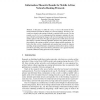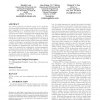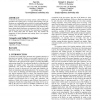160
Voted
ICOIN
2003
Springer
15 years 6 months ago
2003
Springer
Abstract. In this paper, we define the routing overhead as the amount of information needed to describe the changes in a network topology. We derive a universal lower bound on the...
FPGA
2003
ACM
15 years 6 months ago
2003
ACM
We present a pipelining-aware router for FPGAs. The problem of routing pipelined signals is different from the conventional FPGA routing problem. For example, the two terminal N-D...
97
Voted
FPGA
2003
ACM
15 years 6 months ago
2003
ACM
The routing channels of an FPGA consist of wire segments of various types providing the tradeoff between performance and routability. In the routing architectures of recently dev...
114
Voted
ADHOCNOW
2003
Springer
15 years 6 months ago
2003
Springer
We introduce Space-Time Routing (STR), a new approach to routing in mobile ad hoc networks. In STR, the age of routing state is considered jointly with the distance to the destinat...
109
click to vote
WSNA
2003
ACM
15 years 6 months ago
2003
ACM
—In a sensor network, data routing is tightly coupled to the needs of a sensing task, and hence the application semantics. This paper introduces the novel idea of information-dir...
81
Voted
SIGCOMM
2003
ACM
15 years 6 months ago
2003
ACM
We argue that designing overlay services to independently probe the Internet—with the goal of making informed application-specific routing decisions—is an untenable strategy....
117
Voted
SENSYS
2003
ACM
15 years 6 months ago
2003
ACM
The dynamic and lossy nature of wireless communication poses major challenges to reliable, self-organizing multihop networks. These non-ideal characteristics are more problematic ...
100
Voted
PODC
2003
ACM
15 years 6 months ago
2003
ACM
Routing topologies for distributed hashing in peer-to-peer networks are classified into two categories: deterministic and randomized. A general technique for constructing determi...
108
Voted
PADS
2003
ACM
15 years 6 months ago
2003
ACM
The simulation of large–scale multicast networks often requires a significant amount of memory that can easily exceed the capacity of current computers, both because of the inh...
102
Voted
ISPD
2003
ACM
15 years 6 months ago
2003
ACM
A block-level placement and routing scheme called Fishbone is presented. The routing uses a two-layer spine topology. The pin locations are configurable and restricted to certain ...



